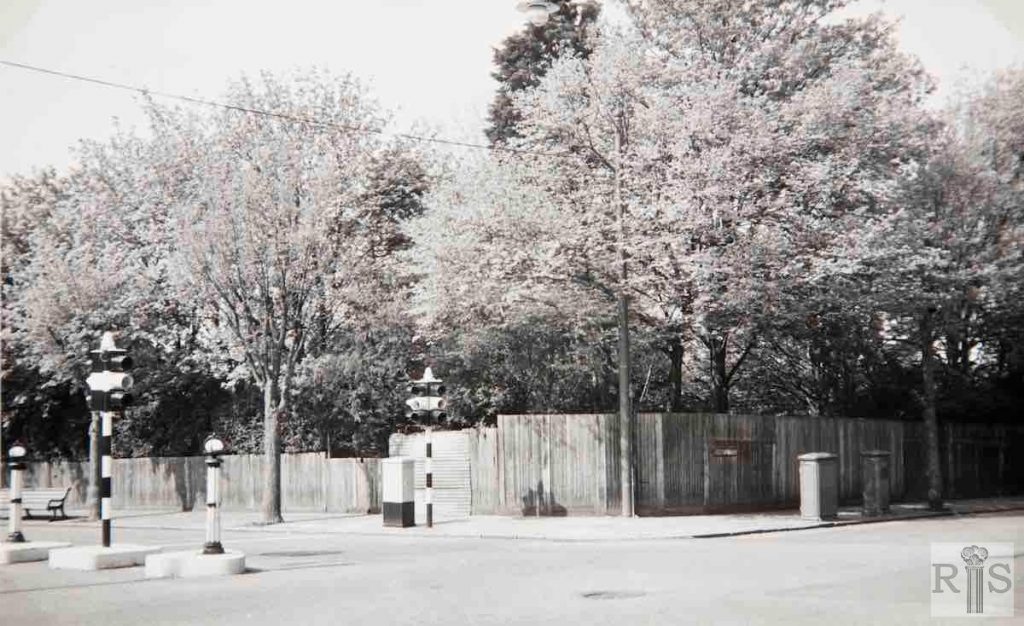
James Gray: One wonders why the photographer took these three very mundane photographs and what sale he anticipated getting. However, 50 or more years later, they are of interest as showing the changes that have taken place. The Palmeira Hotel, Cromwell Road, about 1911 or 1912. This was built, with the rest of Cromwell Road, during the 1880s. Additional Information: Kidd and Holtback’s Ales. jgc_11_117
James Gray: This once quiet road of solid Victorian mansions has long been the object of interest to property developers. All detached and standing in large gardens, the houses are tempting property companies to acquire them for demolition and replace with modern blocks of flats. Here, photographed on 11 February 1973, are two houses 15 & 17 on the west side, sold and awaiting the bulldozer. Within two months 15 had gone and doubtless the other will soon follow. This photograph was taken from Cromwell Road and shows the north façade of No.17. jgc_14_021
James Gray: So comparatively little association football has been played at the County Ground that this must be one of the few photographs to show a team here. Members of the Brighton United F.C. have their backs to the wall at the north end of the ground, with houses in Cromwell Road in the background. jgc_11_124
2018: In the 1890s the County Cricket Ground was home to several football teams from the Brighton area including Brighton United and Brighton Athletic. Football is no longer played here but the ground is regularly used for concerts. It is now overlooked from the north by a large block of modern purpose-built flats called Hovedene which can be seen in the 2018 picture. (Photographer: Alison Minns)
James Gray: The Presbyterian Church at the top of Holland Road was built in 1903-4 and this photograph seems to have been taken shortly after this time. jgc_11_122
2018: The church (St Cuthbert’s Presbyterian Church) which was on the west side of Holland Road with its junction of Cromwell Road has gone. It closed in 1984 and was demolished in the same year. On the site is now a block of retirement flats, Bell Mead, at 124 Holland Road. There are now traffic lights and metal railings at the road junction. (Photographer: Alison Minns)
James Gray: The end of the long garden of 20 Eaton Gardens, May 1958. This land was sold several times before the development of the site began in August 1965. jgc_14_030
2018: The site of 20 Eaton Gardens in the original image is now 31-74 Eaton Manor, three blocks of flats arranged round an inner courtyard, built in the 1960s and designed by local architects, Hubbard Ford & Partners. The 2018 photograph shows the flats at the junction of The Drive and Cromwell Road. The development is part of the Willett Estate Conservation Area and is locally listed. (Photographer: Alison Minns)
James Gray: Thornlea, 76 The Drive. Additional Information: Good view of Vineries attached to the mews behind the main houses. jgc_14_031
2018: 76 The Drive, on the corner of Cromwell Road and The Drive, no longer seems to be called Thornlea. There is now an added 4th storey on the roof. Two west-facing windows have been bricked up. The wrought iron entrance gates have gone. The vinery has gone. The brick wall to the left of the photo has gone to provide an access road to Cambridge Grove. The two northern entrance pillars are shorter. The property is now Grade II listed. (Photographer: Alison Minns)
James Gray: Two photographs taken on 29 May 1983. They show the United Reformed (formerly Presbyterian) Church. Built in 1903/4, at the junction of Cromwell and Holland Roads, it was not dedicated until 1921. As the congregation declined, it was amalgamated with the Cliftonville Congregational Church, and was later closed. Demolished during 1984, it will doubtless be replaced by flats or something similar. jgc_11_136
2018: The church on the corner has now been replaced with Bellmead Court, a block of flats. The two mock-Tudor houses in the foreground have changed little since the original image. (Photographer: Annie Drynan)
James Gray: Two photographs taken on 29 May 1983. They show the United Reformed (formerly Presbyterian) Church. Built in 1903/4, at the junction of Cromwell and Holland Roads, it was not dedicated until 1921. As the congregation declined, it was amalgamated with the Cliftonville Congregational Church, and was later closed. Demolished during 1984, it will doubtless be replaced by flats or something similar. jgc_11_137
2018: The growth of the trees makes it hard to make out the line of the buildings. The Palmeira public house is visible beyond the church in the original image and can just be made out behind the lamp post in the current image. The Palmeira is the only early building that remains after redevelopment of this junction in the 1980s. The Bellmead flats are on the left of the current image. (Photographer: Annie Drynan)
















